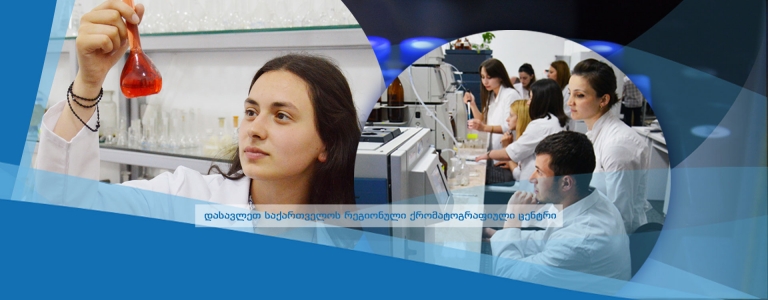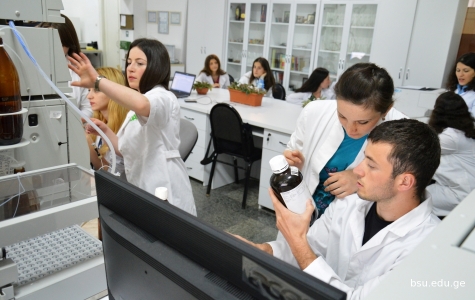
The Western Georgian Regional Center of Chromatography was set up in 2014 at Batumi Shota Rustaveli State University, at the Institute of Membrane Technology and Faculty of Natural Sciences and Health Care.
The Laboratory of the centre of chromatography applies almost two hundreds of methods, approved by the international standards for food safety and environment research. The quantitative and qualitative chromatographic analyses of the pesticides, the quantitative and qualitative chromatographic analyses of the toxins and nitrates, the chromatographic analysis of heavy metals and other ions with the conductivity detector, nitrozoamini, antibiotics, dioxin, their analogues, chromatographic analysis with the mass detector, chromatographic analysis of food additives with the visible, refraction meter or with mass detector etc. are the most notable among the methods.
The Western Georgian Regional Center of chromatography was set up in 2014 at Batumi Shota Rustaveli State University following the obtained grant from the Shota Rustaveli National Science Foundation to study (grant project AP / 96/13, grant manager - Professor Alexander Kalandia, Faculty of Natural Sciences and Health Care, BSU). The laboratory, equipped with the advanced research technologies is important for the capacity building in the region, for the higher education and research institutions. West Regional chromatography centre conducts world-class scientific research.
The center is equipped with modern equipment the following:
High Pressure Liquid Chromatograph: Waters (UV / Visible Detector 2489, Binary HPLC Pump 1525) (ultraviolet and visible range detector), 2414 RI Detector repraktometruli index detector, (Fraction Collector) fractions collector, (multiple columns), ultra-high pressure liquid chromatography system, mass-detector (Acquity UPLC H-Class Core System, Acquity QDa Single Quadupole mass-Detector) (multiple columns), isocratic conductivity detector (Breeze Isocratic Manual 432 conductivity Detector) and gas-liquid chromatography Thermo TRACE 1310 Mainframe 230V, a spectrophotometer Beckman, Spectrophotometer, vacuum vaporizers (with vacuum pump), pH- meters (Mettler Toledo), digital refractometers, digital scales Analytical, supercritical fluid pressure Extractor (SFE 100 with 100 ml pump). adjustable heaters, ultraviolet light source, a water bath, bath ultrasound bath, water temperature controller, household refrigerators (to store samples), drying cabinets, muffle furnaces, centrifuges, necessary chemical vessels, thin-walled chromatography cameras, distillers, Microscope (CCTV), refluxes, soxhlet machines, filtration systems etc. The Centre is equipped with a microbiological laboratory (a box, a sterile room in front of the box, laminar, thermostats, sterilizers, specific utensils).
The Centre carries out a research project, which aims to study the biologically active compounds (phenolic compounds, alcaloids, essential oils, lipoic compounds etc.) in the local and introduced plants in Adjara. The researchers also work to determine the optimal conditions for capturing the raw materials and technology development for extracting concentrates rich with biologically active compounds and drugs development.
The Centre conducts the first survey in Georgia with the contemporary instrumental methods (high-pressure liquid and gas-liquid chromatography, ultra-high pressure chromate-mass spectroscopy) to study the endangered autochtone vine varieties, as well as complete varieties of the biologically active compounds in the grape and wine.
Altogether, the undertaken studies of the citrus species is a novelty, as far as there is no data about the chemical compounds of the citrus species cultivated in the agricultural centre of the Adjara Autoomous Republic Ministry of Agriculture. The chemical composition of the Citrus species are studied with application of the modern physical and chemical methods.
The application of the high-pressure liquid chromatograpy (ultraviolet and visible, refractive metric, gravimetric detectors), gas-liquid chromatography (minimum detector), ultra-high pressure liquid chromate-mass-specrometre, will, for the first time in Georgia, determine the qualitative and quantitative content in the introduced citrus species, i.e. carbohydrates, organic acids, phenolic compounds, vitamins, mineral substances and other biologically active compounds. The study will also focus on the impact of local ecological conditions on the fruit collection and the chemical changes in the introduced citrus species during the storage period.
The modern physico-chemical methods are first applied to study the chemical composition and biologically active compounds of the new variety of stevia, cultivated in the Western Georgia soil and climatic conditions. The new variety of stevia has been introduced to the world market, The research outcomes will enable development of the original complex technology for the crude stevia leaf processing.
The research will make possible, for the first time in Georgia, to determine chemical composition of the physiologically active compounds and the structure of the family Vacciniaceae with the application of the physical and chemical, as well as with the modern instrumental methods. The project will implement comparative characterization of the biologically active compounds in the local and introduced varieties. The study will account for the agro-ecological factors on the biologically active compounds in these species and varieties.
The modern physico-chemical methods will be applied for the first time to study the local varieties and wild species of plum and narrowleaf plantain. The project will adapt and improve qualitative and quantitative research of the biologically active compunds with the high pressure liquid chromatography. The research will determine the antioxidant activity of raw materials and processed products. The research outcomes will be useful for the further utilization of the biological substances, to get the concentrates rich with the biologically active compounds, pharmaceuticals, and natural dyes.
Under Construction...
| Back |


